‘Value the marginal’ – An appreciation of the ‘edges.’
As I write this, it’s still just the middle of Feb, so theoretically still winter.
Winter here has been mostly wet & windy with just a week when snow covered everything with a beautiful glistening white blanket.
The winter is usually the time when we get to love the woodland with our chainsaws. Restructuring the tree-plantation we had inherited, dealing with storm damage and working on the edges of Wilkies Woods. (Besides cutting Christmas trees, of course).
But by the time you get to read this spring will be here.
Already the yellow tassels on the hazel trees are bravely promising a warmer, brighter season to come. The margins between winter and spring…
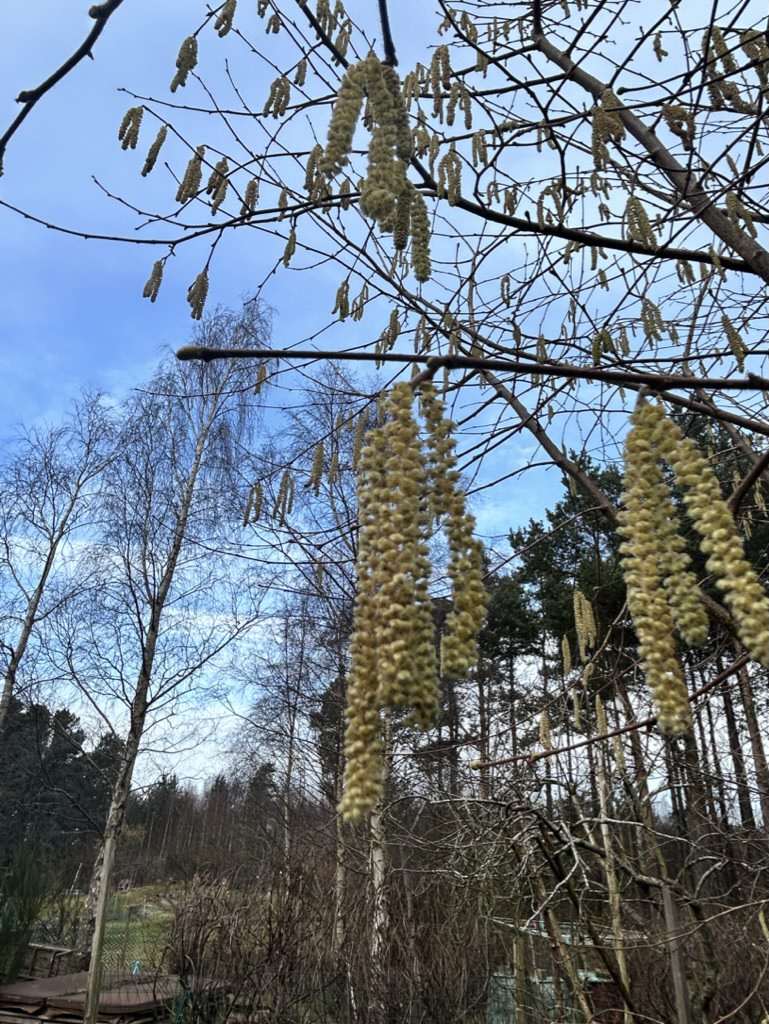
But let me share a bit about our work on the ‘edges‘, the ‘margins’ of our wee woodland…
We have spent quite a bit of time with that again this winter. Lodgepole pines blown down years ago but with a few roots still in the ground have sent up branches looking like medium size trees.
And every year a few more of these trees at the edge of the woods get blown down. The resulting impenetrable tangle – with brambles doing their bit – are useful refuges and hiding places for wildlife. But long term they are not really healthy edges.
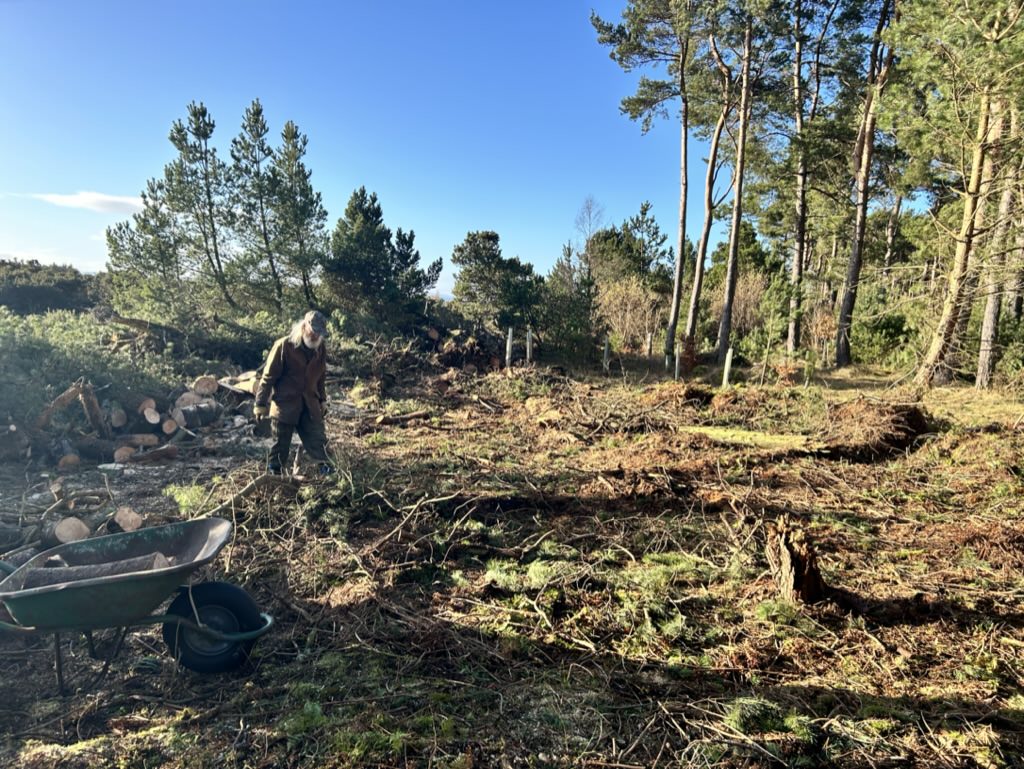
‘Edges’ and the margins of the forest are potentially the places of greatest vitality of a woodland, or a garden, compared to the darker centre of the woods.
In a tree plantation, like the one we inherited, trees were uniformly planted and fenced in. They grew up and after 50 or 60 years their ‘edges’ are like a tall wall in the landscape. There is no transition to whatever surrounds the forest. And we can see the same thing all over the country – strong winds hit that wall and the trees come down like dominoes.
In a natural environment the baby trees would come up where they can get lots of light & space – at the edges. And trees would settle there which would not have a chance to compete with the tall trees which make up the bulk of the woods. And these lower growing trees would provide a ‘slope’ which guides the wind over the forest.
So we have cleared some stretches of these tumble down, windblown edges and we have planted lower growing trees – mostly rowans, hazels, wild cherries, geans, aspen, hawthorn and blackthorn. Birches usually volunteer themselves here en masse. On older edges like this you can see a dense tangle of wild raspberries, blackberries, maybe honeysuckle and many other things which provide a haven for wildlife.
We here are limited in how far we can allow the forest to expand (mostly we have to stay within existing boundaries) and as we want to cultivate a mixed woodland (mixture of ages and species) we plant the trees which bring the desired diversity. (A mixed woodland is much more resilient against storm, fire, pests and diseases than a monoculture).
But what really fascinates me about ‘edges’ or ‘the marginal’ is how it relates to our own human nature. Of course we all deserve to have a safe place to come home to (the middle of the forest). But isn’t it true that when we take risks, when we dare to step into the unknown, when we deal with ‘edgy’ stuff – that these are the moments when we feel most alive?
We only ever grow at our ‘edges’, right?
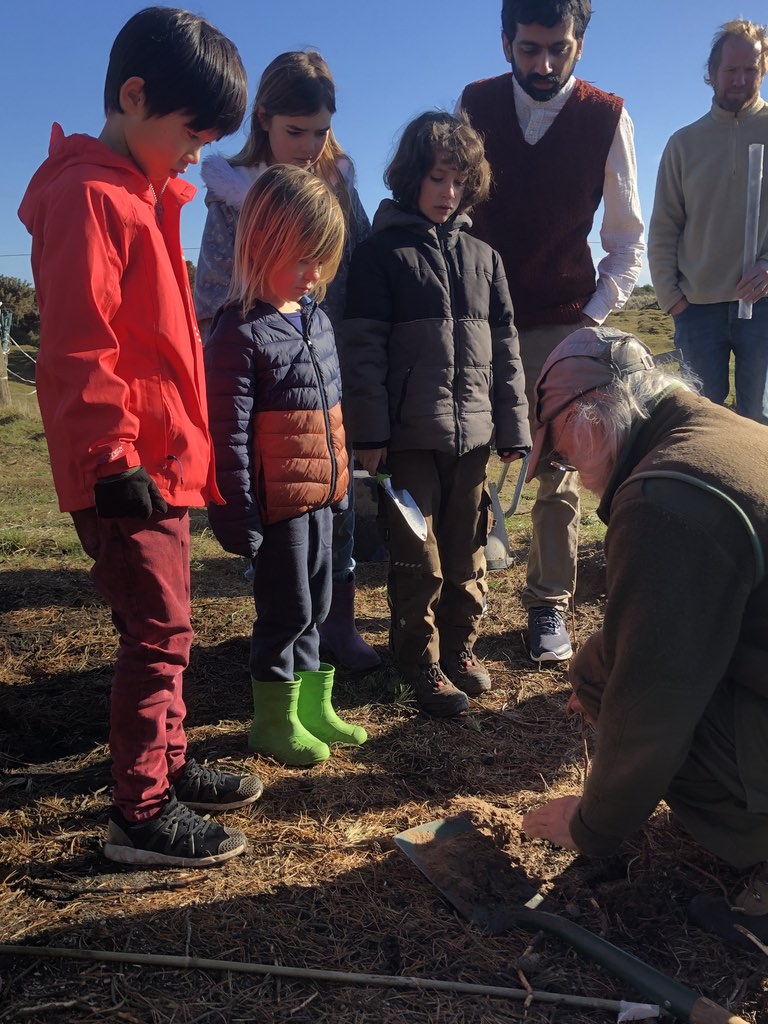
When I walk on a narrow path in the mountains with the land dropping off steeply on one side and rising steeply on the other – that is no time to be half asleep – I need to be wide awake! Because I take a risk and walk somewhere where the lack of mindfulness would be rather dangerous.
‘Edges’ of course also relate to ‘boundaries’. Permaculture suggests to ‘maximize your edges’ – avoid hard, straight lines but make your edges/boundaries soft, curvy, and penetrable.
And take our societies – How much more vibrant and alive our cultures would be if we found ways to truly integrate the marginalized parts of our societies. The travellers, the migrants and immigrants, people who are a bit different than mainstream society. Integrating them without robbing them of their uniqueness, their identity, of course.
Fittingly another permaculture principle says: “Integrate, don’t segregate.’
And even more personal, isn’t this the personal work we are all called to do? To recognise that everything in nature has its valuable role to play and to integrate those wild and woosely bits. On our land and within ourselves.
To live a ‘holy life’ we have to do what we can to become whole.
Integrated.
And it usually starts with the ‘edgy’ stuff.
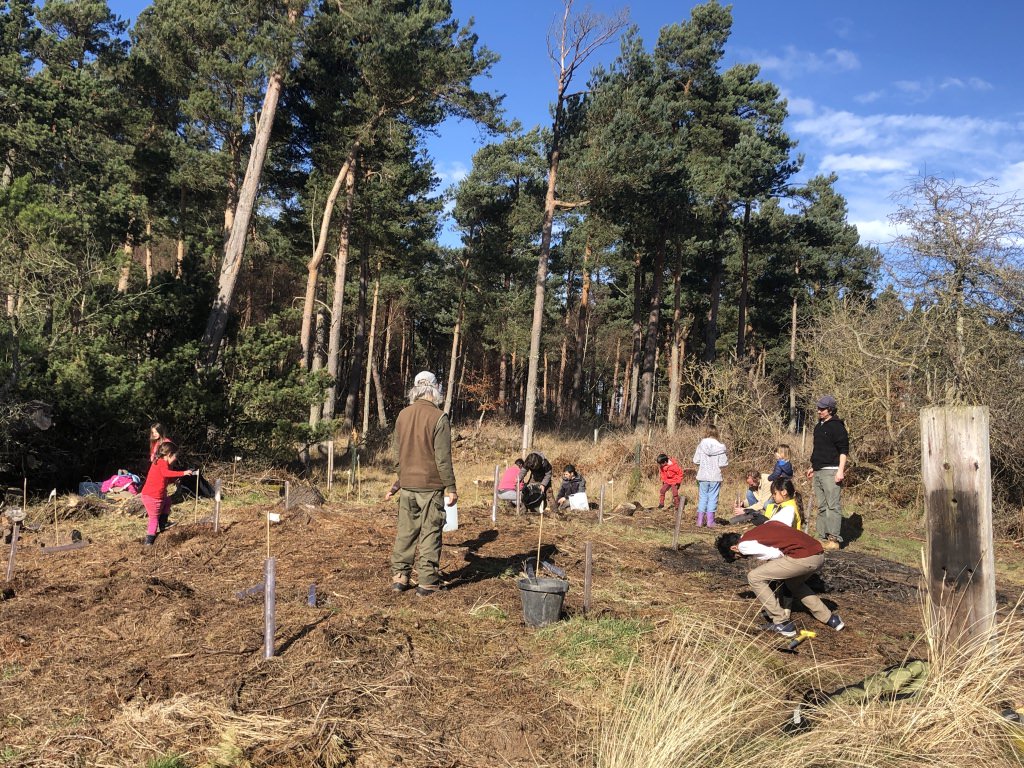
There has been other work going on on the land this winter – mostly to do with the ‘Duneland restoration project’ which you can read about elsewhere in this Newsletter.
I have loved the more introspective time winter offers to us.
But I am beginning to look forward to warmer, brighter days…
Wishing you that – warmth and light…
Many blessings,
Kajedo Wanderer
FHT Land Manager
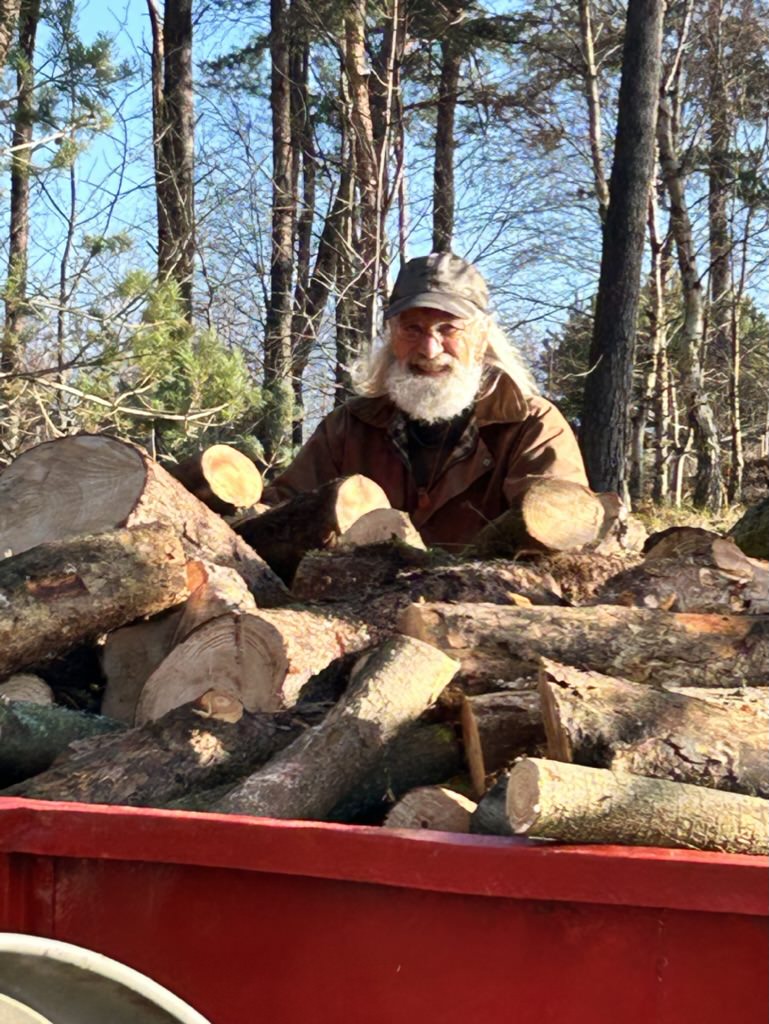

















News From The Land – February 2024
‘Value the marginal’ – An appreciation of the ‘edges.’
As I write this, it’s still just the middle of Feb, so theoretically still winter.
Winter here has been mostly wet & windy with just a week when snow covered everything with a beautiful glistening white blanket.
The winter is usually the time when we get to love the woodland with our chainsaws. Restructuring the tree-plantation we had inherited, dealing with storm damage and working on the edges of Wilkies Woods. (Besides cutting Christmas trees, of course).
But by the time you get to read this spring will be here.
Already the yellow tassels on the hazel trees are bravely promising a warmer, brighter season to come. The margins between winter and spring…
But let me share a bit about our work on the ‘edges‘, the ‘margins’ of our wee woodland…
We have spent quite a bit of time with that again this winter. Lodgepole pines blown down years ago but with a few roots still in the ground have sent up branches looking like medium size trees.
And every year a few more of these trees at the edge of the woods get blown down. The resulting impenetrable tangle – with brambles doing their bit – are useful refuges and hiding places for wildlife. But long term they are not really healthy edges.
‘Edges’ and the margins of the forest are potentially the places of greatest vitality of a woodland, or a garden, compared to the darker centre of the woods.
In a tree plantation, like the one we inherited, trees were uniformly planted and fenced in. They grew up and after 50 or 60 years their ‘edges’ are like a tall wall in the landscape. There is no transition to whatever surrounds the forest. And we can see the same thing all over the country – strong winds hit that wall and the trees come down like dominoes.
In a natural environment the baby trees would come up where they can get lots of light & space – at the edges. And trees would settle there which would not have a chance to compete with the tall trees which make up the bulk of the woods. And these lower growing trees would provide a ‘slope’ which guides the wind over the forest.
So we have cleared some stretches of these tumble down, windblown edges and we have planted lower growing trees – mostly rowans, hazels, wild cherries, geans, aspen, hawthorn and blackthorn. Birches usually volunteer themselves here en masse. On older edges like this you can see a dense tangle of wild raspberries, blackberries, maybe honeysuckle and many other things which provide a haven for wildlife.
We here are limited in how far we can allow the forest to expand (mostly we have to stay within existing boundaries) and as we want to cultivate a mixed woodland (mixture of ages and species) we plant the trees which bring the desired diversity. (A mixed woodland is much more resilient against storm, fire, pests and diseases than a monoculture).
But what really fascinates me about ‘edges’ or ‘the marginal’ is how it relates to our own human nature. Of course we all deserve to have a safe place to come home to (the middle of the forest). But isn’t it true that when we take risks, when we dare to step into the unknown, when we deal with ‘edgy’ stuff – that these are the moments when we feel most alive?
We only ever grow at our ‘edges’, right?
When I walk on a narrow path in the mountains with the land dropping off steeply on one side and rising steeply on the other – that is no time to be half asleep – I need to be wide awake! Because I take a risk and walk somewhere where the lack of mindfulness would be rather dangerous.
‘Edges’ of course also relate to ‘boundaries’. Permaculture suggests to ‘maximize your edges’ – avoid hard, straight lines but make your edges/boundaries soft, curvy, and penetrable.
And take our societies – How much more vibrant and alive our cultures would be if we found ways to truly integrate the marginalized parts of our societies. The travellers, the migrants and immigrants, people who are a bit different than mainstream society. Integrating them without robbing them of their uniqueness, their identity, of course.
Fittingly another permaculture principle says: “Integrate, don’t segregate.’
And even more personal, isn’t this the personal work we are all called to do? To recognise that everything in nature has its valuable role to play and to integrate those wild and woosely bits. On our land and within ourselves.
To live a ‘holy life’ we have to do what we can to become whole.
Integrated.
And it usually starts with the ‘edgy’ stuff.
There has been other work going on on the land this winter – mostly to do with the ‘Duneland restoration project’ which you can read about elsewhere in this Newsletter.
I have loved the more introspective time winter offers to us.
But I am beginning to look forward to warmer, brighter days…
Wishing you that – warmth and light…
Many blessings,
Kajedo Wanderer
FHT Land Manager